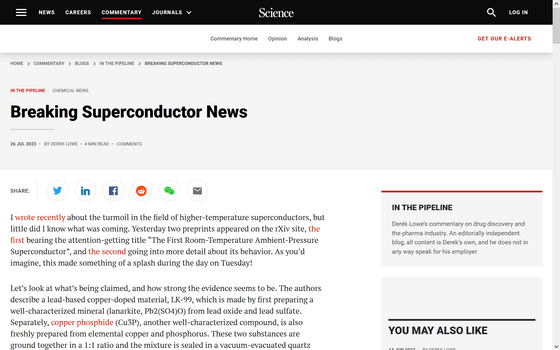The scientific journal Science explains a paper that synthesizes a substance that becomes ``superconducting'' at normal temperature and pressure

by
On July 22, 2023, a paper was submitted on July 22, 2023 that overturns the conventional wisdom of ``realizing superconductivity even at room temperature'' on the phenomenon of ``superconductivity,'' in which the electrical resistance of a specific substance becomes 0 when cooled. The content of this paper is explained by organic chemist and writer Derek Lowe.
Breaking Superconductor News | Science | AAAS
https://www.science.org/content/blog-post/breaking-superconductor-news

Superconductivity that occurs when substances such as metals and compounds are cooled to extremely low temperatures basically does not occur unless it is cooled to a temperature close to -200 degrees. It was known that it was common knowledge that it occurred in a low temperature environment to the extent that it was finally called 'high temperature superconductivity'.
However, a paper stating that this superconductivity was realized even in an environment of up to 127 degrees was suddenly published on the preprint server arXiv, and researchers who were interested in superconductivity were greatly excited.

The authors describe a copper-doped lead material, LK-99, in their paper. LK-99 is made by preparing the mineral ' lanalkite (Pb2(SO4)O) ' which has characteristics of lead oxide and lead sulfate. Separately, we newly prepared copper phosphide (Cu3P), another well-known compound, from elemental copper and elemental phosphorus, ground these two substances in a 1:1 ratio, and vacuumed the mixture. When it is sealed in an evacuated quartz tube and heated to 925 ° C, LK-99 with the chemical formula Pb10-xCux(PO4)6O is formed and becomes a dark polycrystalline. ``Its structure is very similar to the well-known phosphate mineral lead apatite, but with the substitution of copper atoms for certain lead atoms in the lattice, the crystallographic unit The cells are slightly smaller,' he said.
And the authors say that this compound has the feature `` perfect diamagnetism (Meissner effect) '' that magnetizes in the opposite direction so as to cancel the magnetic field from the outside of the superconductor. The authors show that the distorted structure of this material results in the formation of numerous ' quantum wells ' between certain lead atoms and the adjacent oxygens of the phosphate groups attached to them, effectively creating a two-dimensional ' electron gas .' I believe that 'I don't know enough about solid state physics to judge this proposal,' Lowe said. They present data and demonstrate the behavior that superconductors should have, such as the Meissner effect, the rapid change in resistivity at the critical temperature, etc. If these data can be reproduced, this material Superconductivity seems beyond doubt.'

Regarding LK-99, which is expected to be a discovery that shakes the industry, Mr. Lowe mentions that ``the preparation procedure is extremely simple'' as an advantage. 'I really hope the researchers are as they claim,' Lowe said. There is no doubt that they are trying to reproduce the superconductor.The first sample should be coming out soon.”
Related Posts:
in Science, Posted by log1p_kr






